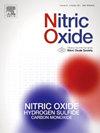低硝酸盐/亚硝酸盐饲粮和添加硝酸盐对产仔数和胎胎盘生长的影响
IF 3.2
2区 生物学
Q2 BIOCHEMISTRY & MOLECULAR BIOLOGY
引用次数: 0
摘要
在妊娠期,一氧化氮(NO)在胚胎发育、母体心血管功能、胎胎盘血流和胎儿生长中起着重要作用。虽然已经研究了NO合成酶(NOS)衍生的NO在妊娠中的重要性,但缺乏从膳食硝酸盐中衍生的NO的作用的证据。在此,我们利用饮食操纵策略来研究饮食中硝酸盐的消耗/补充对小鼠妊娠结局的影响。方法妊娠母鼠在妊娠初期分别饲喂标准对照日粮或市售的低NOx(硝酸盐/亚硝酸盐)日粮,同时饮用含有0.7 mM NaNO3或0.7 mM NaCl的饮用水作为对照。在妊娠第17.5天测定妊娠结局(产仔数、胎儿/胎盘重量)以及母体和胎儿血浆硝酸盐/亚硝酸盐浓度。低氮氧化物饲粮对产仔数无影响,但显著降低了胎重和胎盘重(p <;两者均为0.001)。低氮氧化物动物的母体血浆硝酸盐和亚硝酸盐浓度显著降低(分别为p = 0.017和p = 0.003),母体添加0.7 mM NaNO3可恢复硝酸盐水平,但不能恢复亚硝酸盐水平。虽然母体添加NaNO3对胎儿和胎盘重量没有影响,但产仔数显著增加(p = 0.024)。出乎意料的是,低氮氧化物母鼠的食物/能量摄入量显著降低(p <;0.001),表明较低的胎儿和胎盘重量可能是由于营养不足,而不是硝酸盐本身的消耗。这些发现对于解释使用商业低氮氧化物饮食研究硝酸盐消耗影响的研究具有重要意义,特别是在以前未报告食物摄入的情况下。本文章由计算机程序翻译,如有差异,请以英文原文为准。
Impact of low nitrate/nitrite diet and nitrate supplementation on litter size and fetal and placental growth in pregnant mice
Background
In pregnancy, nitric oxide (NO) plays important roles in embryo development, maternal cardiovascular function, fetoplacental blood flow and fetal growth. Whilst the importance of NO synthase (NOS)-derived NO has been studied in pregnancy, evidence for the role of NO derived from dietary nitrate is lacking. Herein, we utilised dietary manipulation strategies to investigate the effects of dietary nitrate depletion/supplementation on pregnancy outcomes in mice.
Methods
Pregnant dams received either a standard control diet or a commercially available nitrate/nitrite depleted (low NOx) diet from the start of pregnancy, along with drinking water containing either 0.7 mM NaNO3 or 0.7 mM NaCl as control. Pregnancy outcomes (litter size, fetal/placental weights) and maternal and fetal plasma nitrate/nitrite concentrations were determined at gestational day 17.5.
Results and discussion
Litter size was unaffected by maternal low NOx diet, but fetal and placental weights were significantly reduced (p < 0.001 for both). Maternal plasma nitrate and nitrite concentrations were significantly lower in low NOx animals (p = 0.017 and p = 0.003, respectively), with maternal 0.7 mM NaNO3 supplementation restoring nitrate, but not nitrite, levels. Whilst fetal and placental weights were unaffected by maternal NaNO3 supplementation, litter size was significantly increased (p = 0.024). Unexpectedly, maternal food/energy intake was significantly reduced in low NOx dams (p < 0.001), suggesting that the lower fetal and placental weights may be due to nutrient insufficiency, rather than nitrate depletion per se. These findings have important implications for the interpretation of studies using commercial low NOx diets to study the effects of nitrate-depletion, particularly where food intake has not been previously reported.
求助全文
通过发布文献求助,成功后即可免费获取论文全文。
去求助
来源期刊

Nitric oxide : biology and chemistry
生物-生化与分子生物学
CiteScore
7.50
自引率
7.70%
发文量
74
审稿时长
52 days
期刊介绍:
Nitric Oxide includes original research, methodology papers and reviews relating to nitric oxide and other gasotransmitters such as hydrogen sulfide and carbon monoxide. Special emphasis is placed on the biological chemistry, physiology, pharmacology, enzymology and pathological significance of these molecules in human health and disease. The journal also accepts manuscripts relating to plant and microbial studies involving these molecules.
 求助内容:
求助内容: 应助结果提醒方式:
应助结果提醒方式:


